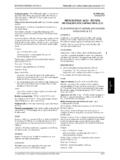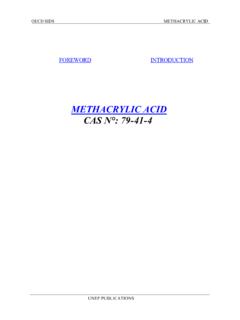Transcription of Monomers Product Guide - Home | Polysciences
1 Monomers Product GuideAcid Containing MonomersAcrylic MonomersAdhesion Promoting MonomersAmine Containing MonomersCrosslinking Acrylic MonomersDual Reactive Acrylic MonomersEpoxides / Anhydrides / ImidesFluorescent Acrylic MonomersFluorinated Acrylic MonomersHigh / Low Refractive Index MonomersHydroxy Containing MonomersMono & Difunctional Glycol Oligomeric MonomersStyrenic MonomersSulfonate Containing MonomersUV Light Active MonomersVinyl & Ethenyl MonomersPolymerization Inhibitors for MonomersFor more information please call (800) 523-2575 or visit: stocks a wide portfolio of Monomers . Such variety offers the synthetic chemist the tools to make a rich array of polymer compositions. Our Monomers Selection Guide organizes this set of reactive Monomers into various groupings. These organized sets of data will enable the scientist to quickly determine which specific monomer can be used to synthesize custom polymers that meet their needs.
2 In reviewing the data in these selection guides, you will be able to compare and contrast monomer alternatives quickly. More detailed information and chemical structures are included in the alphabetical listing which also stocks a wide portfolio of polymers. This variety provides the formulation scientist a useful set of tools to design compositions with markedly different performance. These polymers can also be used by the synthetic scientist as platforms on which to build yet more complex polymer Selection Tables Guide At-A-GlanceAcid Containing Monomers ..3 acid Containing Monomers , Metal Salts ..3 Acrylic Monomers (Neutral, Monofunctional) ..4 Adhesion Promoting Monomers .. 5 Amine Containing Monomers ..6 Crosslinking Acrylic Monomers Difunctional ..7 Crosslinking Acrylic Monomers Multifunctional ..8 Dual Reactive Acrylic Monomers ..8 Epoxides / Anhydrides / Imides ..9 Fluorescent Acrylic Monomers .
3 10 Fluorinated Acrylic Monomers ..11 High / Low Refractive Index Monomers ..11 Hydroxy Containing Monomers ..12 Mono and Difunctional Glycol Oligomeric Monomers ..13 Styrenic Monomers ..14 Sulfonate Containing Monomers ..14UV (light) Active Monomers ..14 Vinyl and Ethenyl Monomers ..15 Polymerization Inhibitors for Monomers ..16 MonomersFor more information please call (800) 523-2575 or visit: # Size acid Containing MonomersAcidic groups are often used to convey solubility to polymers in aqueous media. These moieties can be converted to a wide range of alternative functional groups. acid groups can be utilized as catalysts for chemical reactions. Additionally they are employed in polymers as a functional group which enables improved adhesion to a variety of substrates through hydrogen bonding or metal SitesPolymerizable SynthonForm of AcidSpecial FeaturesAcrylic acid min.
4 Acidmakes water soluble polymers00020-250250 gAcrylic anhydride min. 90%monoacryliccarboxylic acid (protected)not a crosslinker00488-5050 gtert-Butyl methacrylatemonoacryliccarboxylic acid (protected) acid formed by thermal elimination of isobutylene, homopolymer, Tg = 107 C02058-100100 g3-Butene-1,2,3-tricarboxylic acidmono01396-2525 g -Carboxyethyl Acrylate, >98% Activemonoacryliccarboxylic acidhigh purity, hydrophilic24891-100100 gMethacrylic acid , acidhigh purity, hydrophilic24897-250250 gMethacrylic acid , min. acidoffers latex stability, homo-polymer Tg = 185 C00212-450450 g4-Methacryloxyethyl trimellitic anhydridemonoacrylicanhydridehydrolyzed acid offers improved adhesion17285-1010 gMethacryloyl-L-Lysinemonoacrylicamino acidzwitterionic, can derivatize through acid or amine24315-55 go-Nitrobenzyl methacrylate, min. 95%monoacryliccarboxylic acid (protected) acid formed by photolabile deprotection24360-1010 g2-Propene-1-sulfonic acid , sodium salt, 35% soln.
5 In watermonovinylsulfonic acid saltwater soluble00064-1010 g2-Sulfoethyl methacrylate, >90%monoacrylicsulfonic acid esterwater soluble02597-5050 gTrichloroacrylic acidmonoacryliccarboxylic acidcarboxylic acid02686-1010 g4-Vinylbenzoic acidmonostyreniccarboxylic acidversatile -COOH synthesis handle, aromatic acid04485-55 gAcid Containing Monomers , Metal SaltsPolymerizable SitesPolymerizable SynthonForm of AcidSpecial FeaturesBarium methacrylate, >95%dualacrylicmetal saltmetal salt01994-5050 gLithium methacrylatemonoacrylicmetal saltwater soluble17117-5050 gMagnesium acrylatedualacrylicmetal saltionic crosslinking, high Tg polymers02467-1010 gSodium acrylatemonoacrylicmetal saltcan make high Tg salt polymers01207-5050 g3-Sulfopropyl acrylate, potassium saltmonoacrylicsulfonic acid saltwater soluble17209-100100 g3-Sulfopropyl methacrylate, potassium salt, 98%monoacrylicsulfonic acid saltwater soluble17210-100100 gZinc (di)methacrylatedualacrylicmetal saltionomeric crosslinker03011-100100 gMonomersCatalog # Size For more information please call (800) 523-2575 or visit: Monomers (Neutral, Monofunctional)Monofunctional acrylics shape the type and nature of the main chain polymer backbone.
6 Monomers are chosen to obtain the desired glass transition temperature, flexibility, mechanical strength, polarity and hydrophilic/hydrophobic character of the resulting polymer. Generally, acrylamides exhibit improved resistance to hydrolysis compared to acrylic/methacrylic ( C)Special FeaturesN-Acryloylmorpholine147hydrophil ic21192-5050 gBenzhydryl methacrylatehigh RI (ca ), aromatic24286-1010 gBenzyl acrylate, ~99%6high RI (ca ), aromatic01997-100100 gBenzyl methacrylate, min. 95%54high RI (ca ), aromatic02000-100100 gN-Benzylmethacrylamidehigh RI (ca ), aromatic17969-2525 g2-n-Butoxyethyl methacrylate, ~99%moderate polarity02034-100100 gn-Butyl acrylate, min. 99%-54hydrocarbon building block monomer02037-500500 giso-Butyl methacrylate53hydrocarbon building block monomer02056-500500 gn-Butyl methacrylate20hydrocarbon building block monomer02059-33 kgsec-Butyl acrylate12hydrocarbon building block monomer02038-2525 gsec-Butyl methacrylate60hydrocarbon building block monomer02057-1010 gtert-Butyl acrylate43hydrocarbon building block monomer02039-250250 gtert-Butyl methacrylate107hydrophobic / protected acid02058-100100 g4-Chlorophenyl acrylate58high RI (ca ), chlorinated aromatic01331-1010 gCyclohexyl acrylate, min 85%19aliphatic, hydrophobic02109-100100 gCyclohexyl methacrylate, ~98%83aliphatic, hydrophobic01837-100100 giso-Decyl acrylate-55hydrophobic, low Tg03008-100100 gn-Decyl methacrylate, 99%-30hydrophobic23344-2525 giso-Decyl methacrylate, min.
7 90%hydrophobic22493-100100 gN,N-Diethylacrylamide, min. 95%polar building block00871-2525 gN,N-Dimethylacrylamide, min. 98%89useful for chromatographic resins02255-100100 gN,N-Dimethylmethacrylamidehydrolytic stability, useful for hydrogels02270-2525 gn-Dodecyl acrylate-3hydrophobic, long chain alkyl02460-5050 gNew! N-Dodecylacrylamidehydrophobic, long chain alkyl25723-55 gN-Dodecylmethacrylamide15hydrophobic, hydrolytic stability04135-1010 gn-Dodecyl methacrylate-55hydrophobic. Low Tg , long chain alkyl02461-250250 g2-Ethylhexyl acrylate-50hydrophobic00587-250250 gN-Ethylmethacrylamidehydrolytic stability, useful for hydrogels02322-1010 g2-(2-Ethoxyethoxy)ethyl acrylate-7002626-100100 g1-Hexadecyl methacrylate22hydrophobic, aliphatic02396-2525 gn-Hexyl acrylate, min. 98%-45hydrophobic, aliphatic02411-100100 gNew! N-(Isobutoxymethyl)acrylamide25998-5050 mlMethacryloxyethyl trimethylammonium16639-100100 g2-Methoxyethyl acrylate-50low Tg monomer02487-100100 g2-Methoxyethyl methacrylate, polarity02488-100100 gMethyl methacrylate, min building block monomer00834-11 liter2-Naphthyl acrylate24 Hydrophobic, fluorescent, aromatic06024-11 gNeopentyl methacrylatehydrophobic06127-1010 gN-(n-Octadecyl)acrylamidehydrophobic046 73-1010 gn-Octyl methacrylate, 99+%-20hydrophobic23355-2525 gN-tert-Octylacrylamidehydrophobic, hydrolytic stability03141-2525 gPentabromophenyl acrylatehigh RI (ca ), brominated, flame retardent06344-1010 gPentabromophenyl methacrylatehigh RI (ca )
8 , brominated, flame retardent04253-55 gPentafluorophenyl acrylateperfluorophenyl, low surface energy06349-55 gPentafluorophenyl methacrylate, 95%perfluorophenyl, low surface energy06350-55 g2-Phenoxyethyl methacrylate54aromatic, hydrophobic02640-100100 gPhenyl acrylate, min. 95%57UV absorbing, aromatic02642-1010 gMonomersCatalog # Size For more information please call (800) 523-2575 or visit: ( C)Special FeaturesPhenyl methacrylate , >95%110moderate UV absorbing, aromatic, hydrophobic02644-1010 g2-Phenylethyl acrylate,min. 92%-3moderate UV absorbing, aromatic, hydrophobic02834-100100 g2-Phenylethyl methacrylate,min. 92%26moderate UV absorbing, aromatic, hydrophobic02911-100100 gn-Propyl acrylate-37building block monomer03132-2525 gn-Propyl methacrylate35building block monomer03174-100100 gN-iso-Propylacrylamide85hydrophilic0245 5-2525 gStearyl acrylate35hydrophobic, can form crystal domains02636-100100 gStearyl methacrylate3802637-100100 gTetrahydrofurfuryl acrylate-1202907-250250 gTribromoneopentyl methacrylatebromo non-aromatic03057-1010 g2,4,6-Tribromophenyl acrylatehigh RI (ca ), brominated aromatic03330-1010 gTriethylene glycol monomethyl ether monomethacrylatehydrophilic18556-500500 g3,3,5-Trimethylcyclohexyl methacrylatealiphatic, bulky02660-2525 gUndecyl methacrylatehydrophobic02544-2525 gAdhesion Promoting MonomersFunctional groups known to increase adhesion of polymers to surfaces include phosphate and carboxylic acids (metal adhesion) and silyl ethers (glass/siliceous adhesion)
9 Which hydrolyze to give reactive Si-OH bonds. While these Monomers are well studied examples, many Monomers having functional groups such as acids, amines and hydroxyls can also impart polymer adhesion to various substrates. Please refer to other tables for a more expansive listing of these Monomers . Also see Amine monomer SitesPolymerizable SynthonAdd l. ReactiveFunctionalitySpecial FeaturesAcrylic acid min. acidacid provides metal adhesion00020-250250 gBis(2-methacryloxyethyl) phosphatedualacrylicphosphatecrosslinkin g monomer with adhesion promoting capabilties, good for metals16041-1010 g2-(Methacryloxy)ethyl phos-phatemonoacrylicphosphateused for introducing phosphorus into polymers, adhesion promoter25422-5050 ml4-Methacryloxyethyl trimellitic anhydridemonoacrylicanhydrideadhesion promoter through anhydride17285-1010 g3-Methacryloxypropyltrime-thoxysilanemo noacrylicsilyl etherethers react with glass surfaces to improve adhesion, glass pretreatment for polyacrylamide gels02476-250250 gMonoacryloxyethyl phosphatemonoacrylicphosphateused for introducing phosphorus into polymers, adhesion promoter22468-1010 gVinyltriethoxysilanemonovinylsilyl etherreactive silyl ethers hydrolyze affording bonding sites to siliceous surfaces04537-5050 gMonomersCatalog # Size For more information please call (800) 523-2575 or visit: Containing MonomersAmines are among the most widely versatile functional groups.
10 In biopolymers, amines are the key synthetic handle to build structure and architecture to a polymer. Amine groups can act as base catalysts, can be quaternized to yield aqueous soluble polymers and can function as ligands to a variety of metals. Amines are good nucleophiles and can be converted to a wide set of functional groups. Amines can form salts with carboxylic and phosphoric acids to form biologically interesting complexes and SitesPolymerizable SynthonAdd l. Reactive FunctionalitySpecial Features2-Acryloxyethyltrimethylam-moniu m chloridemonoacrylicquaternary,HCI salt17981-250250 g1-(Acryloyloxy)-3-(Methacryloyloxy)-2-P ropanoldualacrylic25351-5050 ml2-Aminoethyl methacrylate hydrochloride, min. 95%monoacrylicprimary,HCI salt21002-1010 gN-(2-aminoethyl) methacryl-amide hydrochloridemonoacrylicsecondary,HCI salt24833-55 gN-(t-BOC-aminopropyl)methacrylamidemono acrylicprimary (protected)solvent soluble for primary amine polymers24318-1010 gN-(3-Aminopropyl)methacryl-amide hydrochloride, >98%monoacrylicprimary,HCI salt21200-55 g2-(tert-Butylamino)ethyl methacrylate, min.








